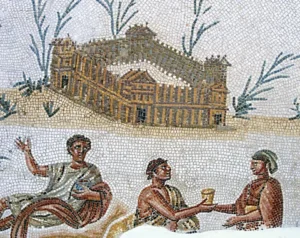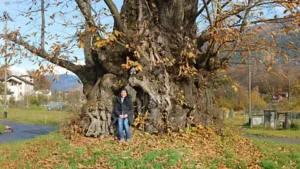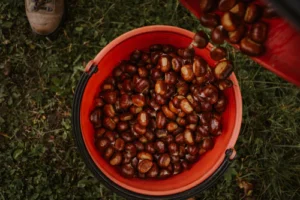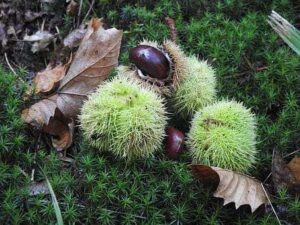Chestnut

The chestnut tree (Castanea sativa), native to Southern Europe and parts of Asia Minor, played a surprisingly significant role in tracing not just the culinary habits of Romans, but also the socio-economic and environmental shifts across the Roman Empire.
It was:
-
A source of food in mountainous regions.
-
A survivor in poor soils where grains wouldn’t grow.
-
A resilient species that expanded with Roman colonization and shrank after Rome’s decline.

Rise of the Roman Empire and the Chestnut’s Spread
1. Early Rome (500 BCE – 200 BCE)
-
Romans primarily cultivated grains like wheat and barley.
-
Chestnuts were known but not central—mostly consumed in rural or mountainous areas like the Apennines.
-
It was considered a peasant food, roasted or ground into flour.
2. Expansion Phase (200 BCE – 100 CE)
-
As the Roman Empire expanded across Europe, agriculture had to adapt to different terrains.
-
In rocky, mountainous regions (like Gaul, Northern Italy, and the Balkans), chestnut trees were ideal.
-
The Roman army relied on sustainable, portable food, and chestnuts—easy to store, high in carbohydrates—fit the need.

Key Insight: Chestnuts expanded with Roman roads, trade routes, and colonization—marking the spread of Roman agricultural practices.
3. Peak Roman Empire (100 CE – 300 CE)
-
Chestnuts began gaining popularity:
-
Used in porridge, flour for bread, and even in Roman delicacies.
-
Written about by Pliny the Elder, who noted chestnut’s health benefits.
-
-
Roman villas in Europe often included chestnut groves.
-
Seen as a symbol of Roman adaptation: how the empire modified nature to feed its population.

Fall of the Roman Empire (300 CE – 500 CE)
1. Decline in Infrastructure
-
As Roman administration weakened, road maintenance and trade faltered.
-
Large-scale grain transport declined.
-
Populations in hilly/mountainous areas became more isolated and self-reliant.
Result: Chestnuts became a crucial survival crop—one of the few starchy foods still available locally.
2. From Empire to Feudalism
-
After the empire’s fall, agriculture shifted to local economies.
-
Chestnut trees became part of feudal holdings and monastery gardens.
-
In some areas, it became the “tree of life”, substituting grains entirely.

Environmental and Archaeobotanical Evidence
-
Pollen records from soil samples in Italy, France, and Spain show chestnut tree expansion during Roman rule.
-
After the fall, chestnut groves either:
-
Survived in isolated mountain regions.
-
Or were replaced by forest as land was abandoned.
-
Cultural Symbolism
-
Chestnuts reflected:
-
Roman resilience and adaptability.
-
The empire’s reliance on nature.
-
A decline into subsistence after the fall.
-
In literature and folklore of the medieval period, chestnuts came to symbolize humility, endurance, and rural survival.

Conclusion
The humble chestnut is more than a food source—it’s a biological witness to the rise and fall of one of history’s greatest empires.
Rise: It traveled with the Roman legions, fed the rural masses, and supported distant provinces.
Fall: It stood as a last-resort staple when imperial systems collapsed.
It remains a living relic of Roman ingenuity, environmental change, and survival through the ages.

